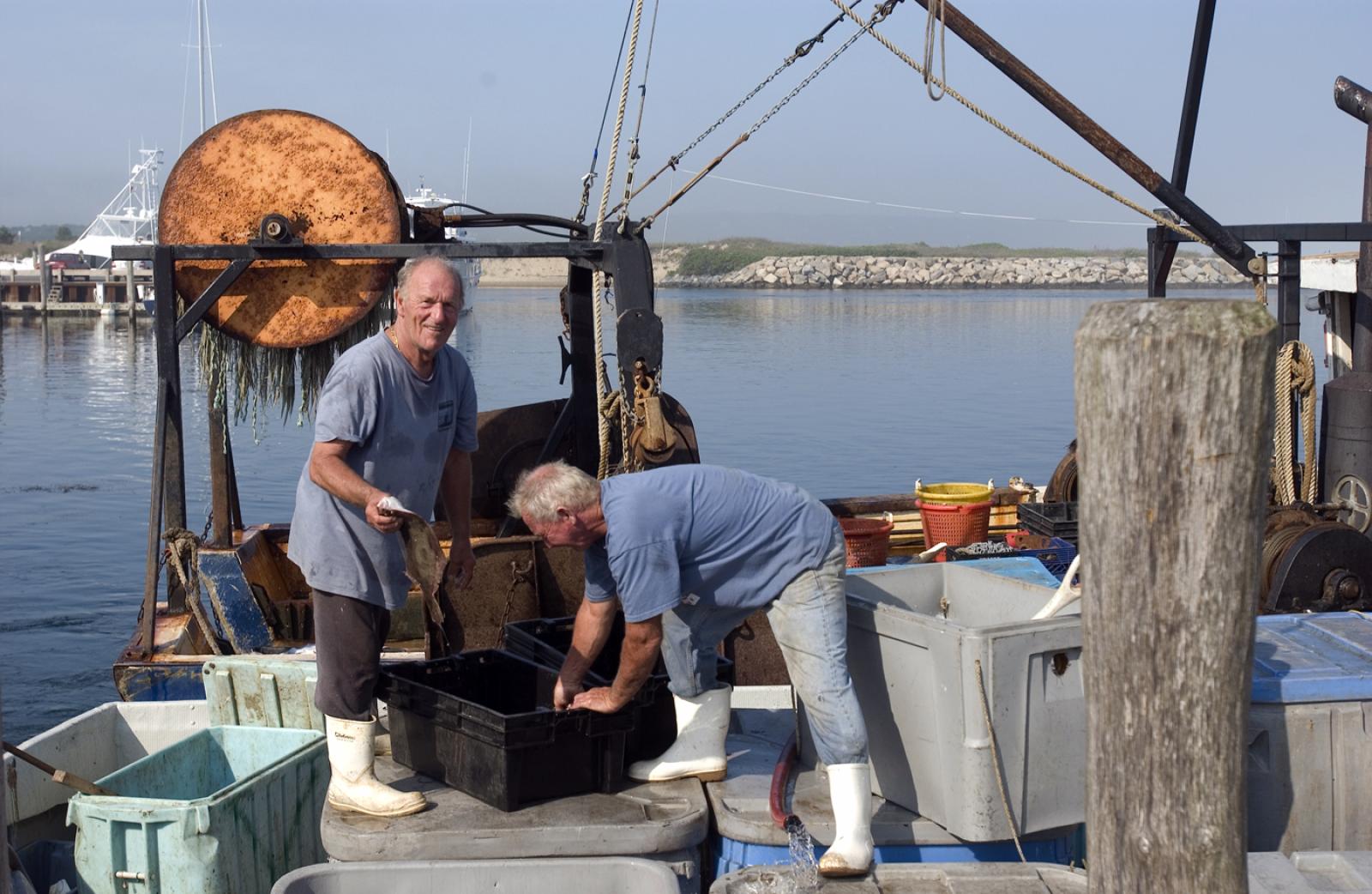The summer flounder, also called fluke, season is about to come to an end. The state will close the commercial season on Tuesday, August 11. The recreational season will close three days later.
Commercial fishermen cannot land any more fluke after 8 p.m. Tuesday. As of the end of last week, 85 per cent of the quota was taken in two months of fishing. The season opened on June 10 and the fishermen have had little trouble getting their 300-pound daily trip limit.
Mike deConinck of the fishing boat Mill Point has fished out of Menemsha since the season opened. He was on the dock on Monday morning, unloading his catch with Steve Broderick of the fishing boat 4 Kids. The two were in early from a morning of towing.
Commercial fishermen have been limited to a Massachusetts quota of 702,614 pounds, not a lot of fish for a fleet that is made up of a unique group of small boat fishermen.
Mill Point is an old wooden boat. The fishing boat 4 Kids is also wood.
Mr. deConinck said he and others have been able to catch their daily quota in just one tow of their fishing net. The net fills with the bag limit in just an hour and 45 minutes.
Or, he said, he can get his daily limit in two tows if each tow lasts an hour. Menemsha Bight and Vineyard Sound are prime spots for fishing for fluke.
If they leave the dock by 6 a.m., Mr. deConinck is usually back at the dock with his catch well before all the parking spaces are taken by bathers at Menemsha Beach.
Mr. deConinck is fortunate. His wife, Kathy, works at Larsen’s Fish Market, so they both have plenty of reason to rise early in the morning.
A former member of the Massachusetts marine fisheries commission, Mr. deConinck is well known in the fishing community and widely respected for his perspective on fish and fishermen.
Once the commercial fluke season ends, many of Menemsha’s draggers will disperse. If you haven’t eaten fluke yet this summer, now is the time.
The recreational fishing season for fluke will also end and that means anglers can’t possess fluke.
While the fluke season is coming to a close, the blue mussel season is in full gear in Menemsha Pond.
Stanley Larsen, who runs Menemsha Fish Market, said he was out on Tuesday at noon harvesting at least 2,000 pounds of blue mussels to keep up with demand. The mussels are coming off the rocky bottom in the pond and they are every bit as good as those blue mussels imported to the Vineyard from as far away as Canada.
Mr. Larsen said there are natural blue mussels beds in the pond and they’ve been producing great bivalves for years. They have no pea crabs, which makes them highly marketable beyond the Vineyard. “We try and go out every other day and get from 2,000 to 3,000 pounds,” Mr. Larsen said.
Saturday is two-for-one blue mussels at Mr. Larsen’s fish market.
Rick Karney, director of the Martha’s Vineyard Shellfish Group, has high praise for the landing of blue mussels on the Vineyard. Mr. Karney and a group of other fishermen are working on establishing a commercial blue mussel farm offshore. Mr. Karney said that Mr. Larsen’s blue mussels coming from Menemsha Pond are a highly praised product. “From the standpoint of a politically correct food, you can’t eat a more efficient source of animal protein,” Mr. Karney said.
Mr. Larsen said he prefers to steam the blue mussels with a bit of butter. That is all that’s required.
Mr. Larsen said Menemsha harbor is bustling with fish and boating activity, especially this week. Bluefish and striped bass are coming in regularly.
His brother, Karsten Larsen of Chilmark, left on Tuesday to go on a several-day trip long-lining for swordfish. Karsten is fishing out of a boat called Kathleen E.
Stanley Larsen said Karsten has been working continuously for weeks gearing up the boat for the trip. It’s loaded with electronics and plenty of high tech gear. Stanley Larsen said he expects Karsten will be back before the end of the week with fresh swordfish.
Stanley Larsen said offshore sea scallops have been landed at the dock.
Edible Sea Robins
Robert Woodruff of West Tisbury was out fishing Lobsterville Beach Tuesday night around sunset expecting to catch striped bass. He said the word was out that striped bass were in thick last weekend at the popular early evening fishing spot. “You could have walked on the heads, I heard,” Mr. Woodruff said.
Instead of catching what he wanted, Mr. Woodruff said he did better than most. He caught a fish. It was a foot-long sea robin. As he brought the fish in, Mr. Woodruff said the fish groaned at him. Sea robins are one of the few fish that comes out of the sea with a comment to make as it emerges. Squid will squirt ink into the air. A sea robin will make a sound that is somewhere between a groan and a honk.
Mr. Woodruff said he used a lure, a little three-inch rubber fish that had a hook in it.
“Can you eat a sea robin?” he asked.
Yes.
Janet Messineo, one of the Island’s top authorities on sea robins, said not only are they edible, they are delicious. For many years she mounted sea robins for one of the kids’ fishing tournaments held in the fall. She runs Island Taxidermy.
“You can cook them any way you want, though they are a bit hard to fillet. They are thick-skinned and there are spikes on them,” she said.
The meat is tender and not as fishy tasting as some sport fish. “It has really white, solid meat. When you cook it, the meat curls up just like a lobster tail. It is a really tasty fish.
“You can saute in butter, you can even deep fry them.
“It doesn’t have a strong flavor, it is a nice mild, solid meat,” Ms. Messineo said.
Sea robins were quite common in these waters; Ms. Messineo said their numbers seem down. “Twenty-three years ago when I started Island Taxidermy, I used to donate a trophy to the kid who caught the biggest fish in the Kids’ Derby [in the fall],” she said.
In those early years they caught big scup. But then the scup became scarce, so she shifted her attention to mounting sea robins.
“In the last three years there has not been one big sea robin, so I have gone back to mounting the biggest scup,” she said.
“Sea robins are not as plentiful,” she said. “I tell the kids down at the dock to be kind to sea robins, release them. They are becoming scarce like other species,” she said. “I have seen young kids smash them against the dock,” she said.
The perception is that they are an ugly fish. Not so. Before anyone calls a sea robin ugly, take a look at a monk fish, or a sculpin.
“Unless you are going to eat them, I suggest you release them,” she said.
Ms. Messineo is the president of the Martha’s Vineyard Surfcasters Association, a nonprofit Island organization committed to promoting and supporting local recreational fishing.






Comments
Comment policy »